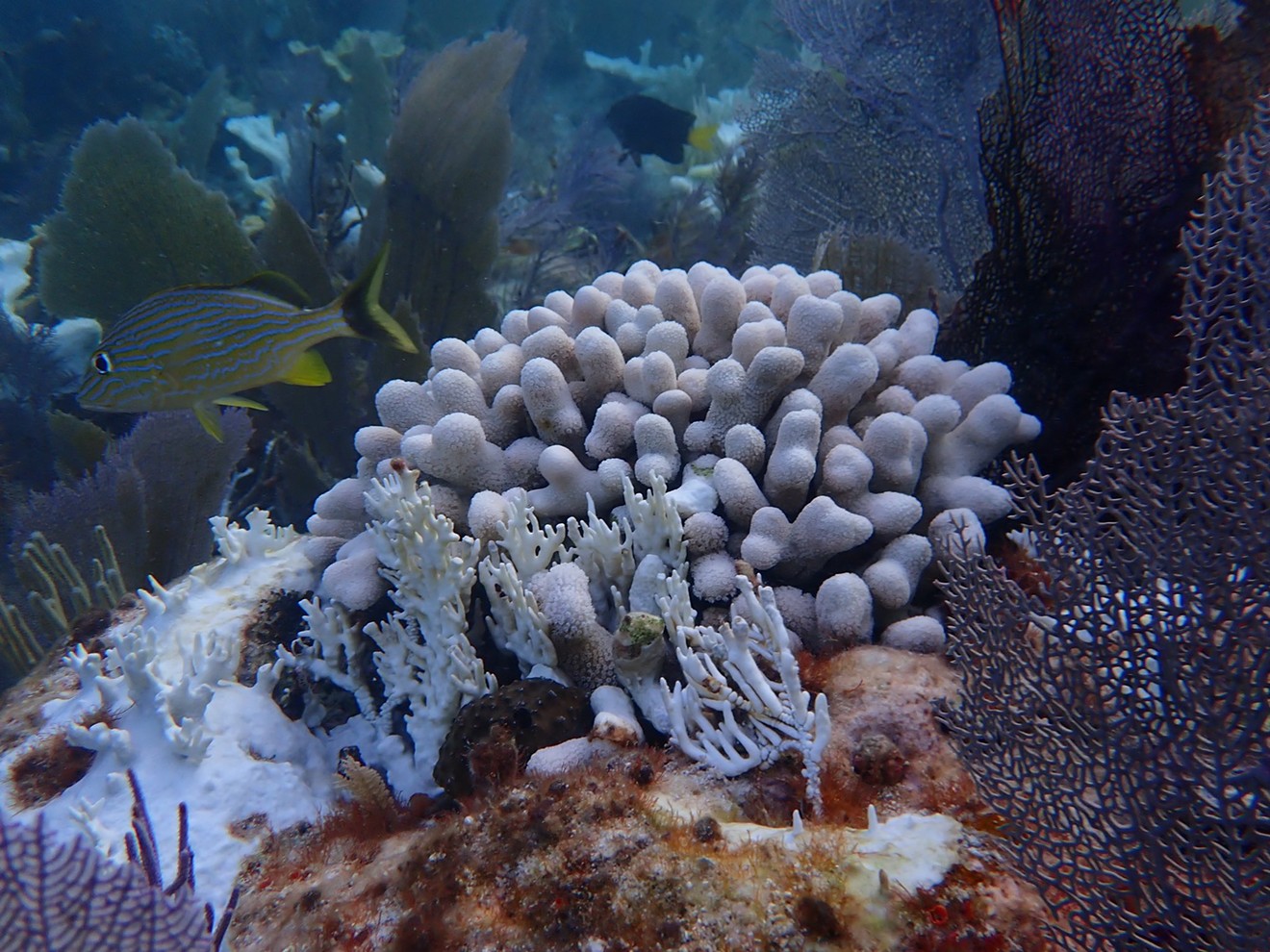After last summer's record-breaking ocean temperatures in South Florida, National Oceanic and Atmospheric Administration (NOAA) researchers have uncovered extensive coral damage at five of seven iconic reefs in the Florida Keys.
On February 14, researchers from NOAA's "Mission: Iconic Reefs" program and partners from Mote Marine Laboratory & Aquarium and the Coral Restoration Foundation surveyed 64 locations at Carysfort Reef, Horseshoe Reef, Sombrero Reef, Looe Key Reef, and Eastern Dry Rocks, and found that only 22 percent of the nearly 1,500 staghorn corals surveyed are still living.
Last July, record-high heat led to mass coral deaths around the Florida Keys after sea temperatures lingered above 90 degrees and peaked above 100 degrees in some spots. High water temperature causes coral to bleach, as it turns white from expelling algae that live within its tissue and give it a distinct color. During the marine heat wave, the reefs in the Keys were classified under the highest possible stress level, meaning "severe coral bleaching and significant coral death, mortality is likely."
As the high water temperatures persisted for weeks, NOAA and other research partners raced to rescue dying, bleached corals and transport them to land-based nurseries before it was too late. Unfortunately, some were not so lucky — marine researcher Katey Lesneski was forced to say goodbye to the elkhorn coral that she had grown to admire at Horseshoe Reef off Key Largo.
"I was crying for nearly the entire dive because I realized that I would likely never see these hundred-plus-years-old colonies alive again," Lesneski, a researcher with the Florida Keys National Marine Sanctuary, told New Times.
During a ten-day assessment of coral at all seven of the iconic reefs in August, NOAA said, researchers found that nearly 90 percent of the surveyed elkhorn and staghorn corals showed signs of bleaching or partial bleaching.
Among other findings in the most recent assessment of coral health in the Keys, NOAA discovered that only Carysfort and Horseshoe Reefs — the two most northern reefs surveyed — had living staghorn coral. Live elkhorn coral was found at three locations: Carysfort Reef, Sombrero Reef, and Eastern Dry Rocks. The researchers did not find any live staghorn or elkhorn corals at Looe Key Reef in the lower Keys.
Sarah Fangman, Florida Keys National Marine Sanctuary superintendent, called the findings "critical to understanding the impacts to coral throughout the Florida Keys following the unprecedented marine heat wave."
"They also offer a glimpse into coral's future in a warming world," she said in a press release. "When the ecosystem experiences significant stress in this way, it underscores the urgency for implementing updates to our regulations."
Though coral can survive bleaching, the process stresses the reef and deprives coral of its primary food source, algae known as zooxanthellae. The algae live within coral in a symbiotic relationship but are expelled in extreme temperatures and the presence of other stressors.
Following last year's reef devastation, NOAA has added three levels to its previous two-level coral reef alert system, with levels 3, 4, and 5 to provide a more detailed scale to describe coral bleaching events.
Lesneski told New Times last summer that Horseshoe Reef has "endured hundreds and hundreds of years of stressors — hurricanes, disease, and prior bleaching events," but that the recent sea temperature spikes pulled the coral to the brink.
"What is happening here and on the rest of the reefs in the Keys and the wider Caribbean is coming into focus as an unprecedented event. The loss of reefs means subsequent ecological collapse and severe economic losses," Lesneski said.
"Mission: Iconic Reefs" aims to restore nearly three million square feet of coral at the seven surveyed reefs through an innovative program involving growing and transplanting coral. The goal is to "restore diversity and ecological function to the reefs by returning coral cover at target reef sites to a self-sustaining level," NOAA says.
According to the agency, damage from hurricanes, coral disease, and bleaching have contributed to worsening health in Florida's reefs since the 1970s. Reefs provide critical habitats for ocean life, ranging from crustaceans to oysters to countless species of fish.
One Australian coral scientist is predicting more "unprecedented mass coral bleaching and mortality" in 2024 based on climate patterns and historical temperature data.
"We are literally in uncharted territory, which we know very little about and don't know how to respond to, and I think we're dangerously exposed," the researcher, Ove Hoegh-Guldberg, said in late 2023.
Environment
NOAA Finds Mass Coral Death in Florida Keys Following Marine Heat Wave
Researchers visited iconic reefs in the Florida Keys and found only 22 percent of the surveyed elkhorn coral remained alive.

The bleached coral Katey Lesneki discovered at Horsehoe Reef off Key Largo during the marine heat wave
Photo by Katey Lesneski
[
{
"name": "Editor Picks",
"component": "17482312",
"insertPoint": "4",
"requiredCountToDisplay": "1"
},{
"name": "Inline Links",
"component": "18711090",
"insertPoint": "8th",
"startingPoint": 8,
"requiredCountToDisplay": "7",
"maxInsertions": 25
},{
"name": "Air - MediumRectangle - Combo - Inline Content",
"component": "17482310",
"insertPoint": "8th",
"startingPoint": 8,
"requiredCountToDisplay": "7",
"maxInsertions": 25
},{
"name": "Inline Links",
"component": "18711090",
"insertPoint": "8th",
"startingPoint": 12,
"requiredCountToDisplay": "11",
"maxInsertions": 25
},{
"name": "Air - Leaderboard Tower - Combo - Inline Content",
"component": "17482313",
"insertPoint": "8th",
"startingPoint": 12,
"requiredCountToDisplay": "11",
"maxInsertions": 25
}
]








